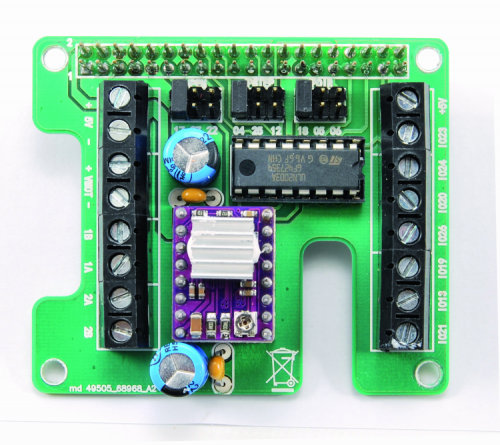
Our scanner
This being said, we may move on to talk about our 3D scan approach, that consists in using a linear laser, that is, one capable of drawing a vertical line having a constant luminous intensity, and in shooting the images that have been determined by the light’s reflection on the object’s surface (that in this case is rotated) by means of a video camera; at each rotation degree (or fraction) corresponds a frame that is digitized and sent to a program capable of processing the surface of the scanned object. Usually, in these systems two lasers (tilted with respect to each other) are used, and the video camera is placed between the two. Our scanner is born out of an elaboration of the PiClop, an open project composed of a mechanics (whose parts to be 3D printed may be downloaded from thingiverse ) and of an electronics formed of the Raspberry Pi 2 board and its video camera; PiClop, as implied by the name, is a free interpretation, based on Ciclop’s Raspberry Pi 2 , a 3D commercial laser scanner and a video camera, supplied with a rotating plate. Even Ciclop (though it is commercialized) is a scanner having an open source information material. Our scanner differs from PiClop since we substituted Raspberry Pi’s video camera with one supplied with an adjustable optics, in addition to the original circuit that has been substituted with one of our shields for the management of the stepper motor (NEMA 17), that rotates the plate and the lasers. We preferred a video camera having an adjustable lens so to optimise the focus of the object, since we realized that the original one in the Raspberry Pi has a focus distance that is greater than the one between the base and the rotating plate that hosts the object to be scanned. Being able to accurately regulate the focus, we are able to obtain the best definition in the calibration stage, before starting the scan. The video camera is a 5MP IR one for Raspberry Pi, having a 3.6 mm adjustable optics.
The said scanner connects to the Internet: the management of all the functions, as well as of the parameter settings occurs via LAN network, therefore it may also be carried out remotely, by means of whatever computer. For the occasion, Raspberry Pi (it must be version 2) will have an image of the operating system with the dedicated management and control software (FreeLSS) installed (on the SD-Card), it is capable of generating files in the following formats: PLY – Colored Point Cloud, XYZ – Comma Delimited 3D Point Cloud, STL – 3D Triangle Mesh. The software implements a web interface, by means of which it is possible to operate with the scanner, that is to say, to carry out the settings and the acquisitions. For each acquisition a file is generated. FreeLSS implements:
- real-time scan preview;
- assisted calibration;
- two-lasers mode is supported;
- up to 6,400 steps per plate rotation;
- Still Mode and Video Mode camera are supported;
- parameter settings as for the image processing;
- the possibility to obtain partial images, so to carry out the debug in the case the scan does not succeed;
- the manual movement of the rotating plate is supported.












